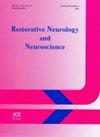Therapeutic interventions of Amyotrophic Lateral Sclerosis (ALS)
IF 1.6
4区 医学
Q4 NEUROSCIENCES
引用次数: 0
Abstract
Amyotrophic lateral sclerosis (ALS) is a non-demyelinating neurodegenerative disease mostly found in adults between 40 to 60 years old. This disease is usually prevalent in males, however it’s irrespective to the different genders. ALS is progressive and within 2-5 years of diagnosis ulimately ends with death. The majority of ALS cases is sporadic (90%) and is recorded without any defined aetiology. The other 10-12% of cases is recognized from mutations in more than 20 genes. The genes reported to cause ALS are Superoxide Dismutase 1 (SOD1), TAR DNA Binding Protein (TDP), Fused in Sarcoma, (FUS), Chromosome 9 Open Reading Frame 72 (c9orf72) and Vesicle-Associated Membrane-ProteinAssociated Protein B (VAPB). Furthermore, abnormal lipid metabolism with higher LDL/HDL ratio was reported in ALS patients. The aetiology of ALS is shown in the schematic diagram below (Figure 1) Due to the multi-nature of ALS causative factors and symptoms, there is no specific therapy for ALS today. However, this paper will touch on potential therapies that are in practice or may come up in the future. The goal is to maintain and improve the function of motor neuron, the well-being and quality of life for ALS patients. Until then, we have to rely on the symptomatic treatment and rehabilitative measures to support the patient’s quality of life.肌萎缩侧索硬化(ALS)的治疗干预措施
肌萎缩性侧索硬化症(ALS)是一种非脱髓鞘性神经退行性疾病,常见于40至60岁的成年人。这种疾病通常在男性中流行,但与不同性别无关。ALS是一种进行性疾病,在诊断后2-5年内最终以死亡告终。大多数ALS病例是散发的(90%),没有任何明确的病因。另外10-12%的病例是由20多种基因突变引起的。据报道,导致ALS的基因有超氧化物歧化酶1 (SOD1)、TAR DNA结合蛋白(TDP)、肉瘤融合(FUS)、9号染色体开放阅读框72 (c9orf72)和囊泡相关膜蛋白相关蛋白B (VAPB)。此外,ALS患者的脂质代谢异常,LDL/HDL比值较高。ALS的病因如下图所示(图1)。由于ALS的致病因素和症状具有多重性质,目前还没有针对ALS的特异性治疗方法。然而,本文将触及潜在的治疗方法,在实践中或可能出现在未来。目标是维持和改善运动神经元的功能,改善ALS患者的健康和生活质量。在此之前,我们必须依靠对症治疗和康复措施来支持患者的生活质量。
本文章由计算机程序翻译,如有差异,请以英文原文为准。
求助全文
约1分钟内获得全文
求助全文
来源期刊
CiteScore
5.40
自引率
3.60%
发文量
22
审稿时长
>12 weeks
期刊介绍:
This interdisciplinary journal publishes papers relating to the plasticity and response of the nervous system to accidental or experimental injuries and their interventions, transplantation, neurodegenerative disorders and experimental strategies to improve regeneration or functional recovery and rehabilitation. Experimental and clinical research papers adopting fresh conceptual approaches are encouraged. The overriding criteria for publication are novelty, significant experimental or clinical relevance and interest to a multidisciplinary audience. Experiments on un-anesthetized animals should conform with the standards for the use of laboratory animals as established by the Institute of Laboratory Animal Resources, US National Academy of Sciences. Experiments in which paralytic agents are used must be justified. Patient identity should be concealed. All manuscripts are sent out for blind peer review to editorial board members or outside reviewers. Restorative Neurology and Neuroscience is a member of Neuroscience Peer Review Consortium.

 求助内容:
求助内容: 应助结果提醒方式:
应助结果提醒方式:


